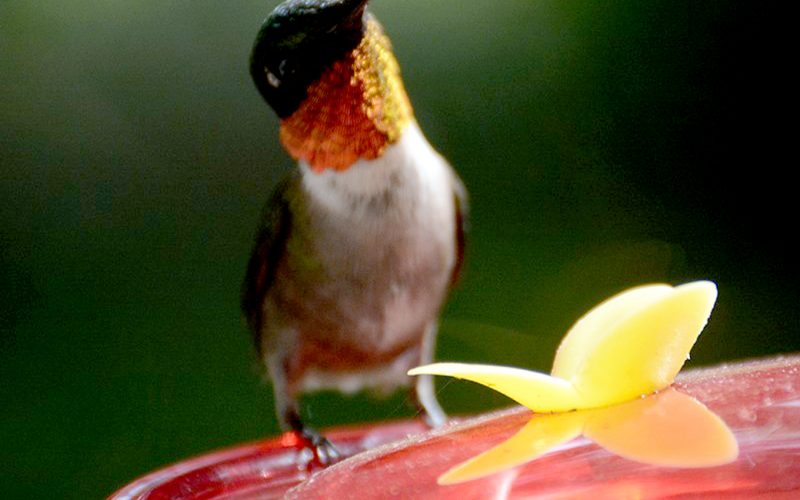
Staff Photo Amanda Bancroft
The ruby-throated hummingbird, pictured here, weighs less than a Bald Eagle primary feather.
Summer is the perfect time to catch a glimpse of our visiting Ruby-throated Hummingbirds in between their spring and fall migrations to tropical climates. Their resplendent feathers and fantastic flight patterns dazzle even those who are familiar with them.
There are plenty of mysteries surrounding our smallest birds. We don’t know everything about how they survive and navigate migration, and how they evolved is still a bit vague. Yet there are things we know through scientific studies and observations of hummingbirds that boggle the mind. Stan Tekiela’s book “Amazing Hummingbirds” is a great read to discover fascinating facts about these tough birds, and contains gorgeous photographs from over twenty years of photographing various species.
Small Birds, Big Numbers: Fast Facts about Hummingbirds
1. A hummingbird’s heart rate during flight is 1,200 beats per minute.
2. There is a 50 percent mortality in their first year, but they can live from 4-12 years.
3. Males can fly at 60 mph with 200 flaps per second during courtship flights.
4. They can ascend to 200-500 feet above ground to gain mileage during migration.
5. Migration over the Gulf of Mexico is a 500 mile journey lasting 18-22 hours nonstop.
We also know what’s not true about hummingbirds. It’s a myth that they only drink nectar from feeders with red coloring in the liquid (and since this could harm their health, it isn’t recommended). They also can’t ride on the backs of Canada Geese or survive only on nectar. They eat insects for protein, prefer nectar flowers over feeders, and enjoy sap from the Yellow-bellied Sapsucker’s holes in trees like the Sugar Maple.
Their aerial acrobatics are impressive: they can fly backwards, and are the only birds with the true ability to hover, fly side to side, up and down, and somersault in midair. The Ruby-throated Hummingbird weighs less than a Bald Eagle primary feather, but hummingbirds aren’t intimidated – they may even chase these much larger birds away! Hummers can be killed by a variety of predators including hawks, a praying mantis, Greater Roadrunners, some spiders and large lizards. Weather events like a hailstorm or frost may also be fatal. Still, they survive to procreate. Females build a camouflaged nest that includes spider webbing for glue and flexibility as the chicks grow and the nest stretches in size.
The best time to watch them is on sunny days, since their most brilliant feathers are the result of structural color, not pigment. To attract hummingbirds to your yard, make sure it provides plenty of nectar flowers blooming throughout the season. They also require a water source and a safe nesting site. The rewards are great if the hummers pick your yard as their territory, but make sure to clean feeders regularly. You might even get to feed hummingbirds by hand once they grow to trust you!
Amanda Bancroft is a writer, artist, and naturalist building an off-grid cottage for land conservation on Mt. Kessler. She and her husband Ryan blog about their adventures and offer a solar-hosted online educational center on how to make a difference with everyday choices at: www.RipplesBlog.org.










